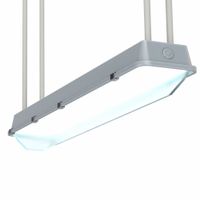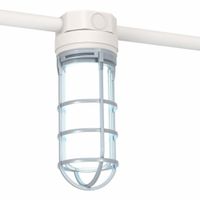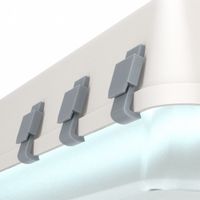Call +(254) 703 030 000 / 751 483 999 / 721 704 777
- Home
- Lighting
- Lighting Fixtures Retrofit Kits
- Vapor Tight Light Fixtures
Vapor Tight Light Fixtures
Vapor-tight lights prevent dust and moisture from entering the fixture and damaging internal wiring and components. Also called gasketed fixtures, their housing and lens fit tightly together and seal with a gasket. They illuminate wet, damp, or humid locations, such as locker rooms, loading docks, p .....Read More
Frequently Asked Questions
What are vapor-tight lights used for?
Vapor-tight lights are used in environments where moisture, dust, and other contaminants are prevalent. These fixtures are designed to be sealed and gasketed, preventing the ingress of water, dust, and vapors, making them ideal for both indoor and outdoor applications where exposure to harsh conditions is a concern. Commonly used in industrial settings, vapor-tight lights are found in factories, warehouses, and food processing plants, where they provide reliable illumination while withstanding challenging conditions.
In addition to industrial applications, vapor-tight lights are also used in parking garages, car washes, and agricultural facilities, where they help maintain safety and visibility despite exposure to water and dirt. They are often installed in areas prone to high humidity, such as bathrooms, locker rooms, and swimming pool areas, ensuring that lighting remains functional and safe.
Vapor-tight lights are also energy-efficient, often utilizing LED technology to provide bright, consistent lighting while reducing energy consumption and maintenance costs. Their robust construction and long lifespan make them a cost-effective solution for environments that demand durability and reliability.
Furthermore, these lights are used in hazardous locations where explosive gases or dust may be present, as they can be designed to meet specific safety standards to prevent ignition. Overall, vapor-tight lights are essential for maintaining effective and safe lighting in environments where traditional lighting solutions would fail due to exposure to moisture, dust, and other environmental factors.
How do vapor-tight lights prevent dust and moisture?
Vapor-tight lights are designed to prevent dust and moisture from entering the fixture, ensuring reliable operation in challenging environments. They achieve this through several key features:
1. **Sealed Enclosure**: The primary defense against dust and moisture is the sealed enclosure. The housing of vapor-tight lights is typically made from durable materials like polycarbonate or fiberglass, which are resistant to corrosion and impact. The enclosure is tightly sealed with gaskets, often made from silicone or rubber, which create a barrier against external elements.
2. **Gasketed Design**: The gaskets are crucial in maintaining the integrity of the seal. They are placed around the edges of the fixture where the lens or cover meets the housing. This design ensures that no gaps are present for dust or moisture to penetrate.
3. **IP Rating**: Vapor-tight lights are often rated with an Ingress Protection (IP) code, which indicates their level of protection against solids and liquids. A common rating for these fixtures is IP65 or higher, meaning they are dust-tight and protected against water jets from any direction.
4. **Secure Fastening**: The fixtures are equipped with secure latches or screws that hold the lens or cover firmly in place. This prevents accidental opening or loosening, which could compromise the seal.
5. **Breather Valves**: Some vapor-tight lights include breather valves that equalize pressure inside the fixture without allowing moisture or dust to enter. This prevents condensation build-up inside the fixture.
By incorporating these features, vapor-tight lights effectively prevent dust and moisture from compromising the internal components, ensuring longevity and consistent performance in environments such as industrial settings, parking garages, and outdoor areas.
What is the difference between round and linear vapor-tight fixtures?
Round and linear vapor-tight fixtures are both designed to protect against moisture, dust, and other environmental factors, but they differ in shape, application, and design features.
1. **Shape and Design**:
- **Round Vapor-Tight Fixtures**: These fixtures are typically circular and compact. They are often used in areas where space is limited or where a more focused light is needed. Their design allows for even light distribution in all directions.
- **Linear Vapor-Tight Fixtures**: These are elongated and rectangular, resembling traditional fluorescent tube fixtures. They provide a more extensive light spread, making them suitable for larger areas.
2. **Applications**:
- **Round Fixtures**: Ideal for smaller spaces such as walk-in freezers, storage rooms, or as accent lighting in industrial settings. They are often used in areas where a concentrated light source is beneficial.
- **Linear Fixtures**: Commonly used in larger spaces like parking garages, warehouses, and industrial facilities. Their design allows for continuous rows of lighting, providing uniform illumination over a wide area.
3. **Installation and Maintenance**:
- **Round Fixtures**: Easier to install in tight spaces due to their compact size. They may require less maintenance as they often have fewer components.
- **Linear Fixtures**: Installation can be more complex due to their size and the need for alignment in continuous rows. However, they are designed for easy maintenance with accessible components.
4. **Aesthetic and Functional Considerations**:
- **Round Fixtures**: Offer a more traditional look and are often chosen for their aesthetic appeal in addition to functionality.
- **Linear Fixtures**: Provide a modern, streamlined appearance and are selected for their efficiency in lighting large areas.
Both types are essential in environments where durability and protection from harsh conditions are required, but the choice between them depends on specific lighting needs and spatial constraints.
What does an IP rating mean for vapor-tight lights?
An IP (Ingress Protection) rating is a standardized measure used to define the level of protection an electrical enclosure provides against solids and liquids. For vapor-tight lights, the IP rating is crucial as it indicates the fixture's ability to withstand environmental factors such as dust, moisture, and vapor, ensuring safe and reliable operation in challenging conditions.
The IP rating consists of two digits. The first digit (ranging from 0 to 6) represents the level of protection against solid objects and dust. A higher number indicates better protection. For example, a rating of 6 means the fixture is completely dust-tight.
The second digit (ranging from 0 to 9) indicates the level of protection against liquids, including water and vapor. A higher number signifies better resistance. For instance, a rating of 5 means the fixture can withstand water jets from any direction, while a rating of 7 indicates it can be submerged in water up to a certain depth for a specified time.
For vapor-tight lights, a common IP rating is IP65, IP66, or IP67. An IP65 rating means the light is dust-tight and protected against water jets. An IP66 rating offers similar dust protection but can withstand more powerful water jets. An IP67 rating provides dust-tight protection and allows the fixture to be submerged in water temporarily.
These ratings ensure that vapor-tight lights can be used in environments with high humidity, dust, or exposure to water, such as industrial settings, outdoor areas, or food processing facilities, without compromising performance or safety.
How do retrofit kits work for vapor-tight fixtures?
Retrofit kits for vapor-tight fixtures are designed to upgrade existing lighting systems to more energy-efficient solutions, such as LED technology, without the need to replace the entire fixture. These kits typically include components like LED lamps or modules, drivers, and necessary mounting hardware.
The process begins by removing the existing light source, such as fluorescent or incandescent bulbs, from the vapor-tight fixture. The retrofit kit is then installed, which often involves attaching an LED module or lamp into the existing fixture's socket or mounting it using brackets or clips provided in the kit. The LED driver, which regulates the power supply to the LED, is either integrated into the LED module or installed separately within the fixture.
Vapor-tight fixtures are designed to be sealed against moisture, dust, and other environmental contaminants, making them suitable for harsh conditions. Retrofit kits are engineered to maintain this seal, ensuring that the fixture remains vapor-tight after the upgrade. This is achieved by using gaskets, seals, and other protective components that come with the kit to prevent any breach in the fixture's integrity.
The benefits of using retrofit kits include improved energy efficiency, reduced maintenance costs, and enhanced lighting quality. LEDs consume less power and have a longer lifespan compared to traditional lighting technologies, leading to significant energy savings and reduced frequency of replacements. Additionally, LEDs offer better light quality, with options for different color temperatures and improved color rendering.
Overall, retrofit kits provide a cost-effective and environmentally friendly solution to modernize lighting systems while preserving the existing infrastructure of vapor-tight fixtures.
Where can vapor-tight lights be installed?
Vapor-tight lights can be installed in various locations where moisture, dust, and other environmental factors are a concern. These fixtures are designed to be sealed against the ingress of water and contaminants, making them ideal for both indoor and outdoor applications. Common installation areas include:
1. **Industrial Facilities**: In factories and warehouses, vapor-tight lights are used to provide reliable illumination in areas exposed to dust, moisture, and temperature fluctuations.
2. **Parking Garages**: These lights are suitable for parking structures where they can withstand exposure to vehicle emissions, moisture, and temperature changes.
3. **Food Processing Plants**: In environments where hygiene is critical, vapor-tight lights prevent contamination and are easy to clean, making them suitable for food and beverage processing areas.
4. **Agricultural Settings**: Barns, poultry houses, and other agricultural buildings benefit from vapor-tight lights due to their resistance to dust, moisture, and animal waste.
5. **Car Washes**: The high moisture and chemical exposure in car washes make vapor-tight lights an ideal choice for providing consistent lighting.
6. **Marine Environments**: On ships and in coastal areas, these lights resist saltwater corrosion and moisture, ensuring durability and safety.
7. **Cold Storage Facilities**: Vapor-tight lights perform well in low-temperature environments, making them suitable for freezers and refrigerated warehouses.
8. **Restrooms and Locker Rooms**: In public facilities, vapor-tight lights are used to prevent moisture ingress and ensure long-lasting performance.
9. **Tunnels and Subways**: These lights are used in transportation tunnels and subways where they can withstand vibrations, dust, and moisture.
10. **Outdoor Walkways and Canopies**: Vapor-tight lights provide reliable outdoor lighting in areas exposed to rain and wind.
By choosing vapor-tight lights for these applications, you ensure enhanced durability, safety, and performance in challenging environments.
What are the benefits of using LED technology in vapor-tight fixtures?
LED technology in vapor-tight fixtures offers several benefits:
1. **Energy Efficiency**: LEDs consume significantly less energy compared to traditional lighting, reducing electricity costs and environmental impact.
2. **Longevity**: LEDs have a longer lifespan, often exceeding 50,000 hours, which reduces maintenance and replacement costs.
3. **Durability**: LED lights are solid-state devices, making them more resistant to shock, vibration, and external impacts, ideal for harsh environments.
4. **Instant Lighting**: LEDs provide instant illumination without warm-up time, ensuring immediate full brightness.
5. **Temperature Tolerance**: They perform well in a wide range of temperatures, making them suitable for both indoor and outdoor applications.
6. **Reduced Heat Emission**: LEDs emit very little heat compared to incandescent and fluorescent lights, reducing the risk of burns and lowering cooling costs.
7. **Environmental Impact**: LEDs are free of toxic elements like mercury, making them environmentally friendly and easier to dispose of.
8. **Design Flexibility**: They are available in various shapes and sizes, allowing for versatile design options in fixtures.
9. **Improved Light Quality**: LEDs offer better color rendering and uniform light distribution, enhancing visibility and safety.
10. **Sealed Protection**: Vapor-tight fixtures protect LEDs from moisture, dust, and contaminants, ensuring reliable performance in challenging conditions.
11. **Cost-Effectiveness**: Despite higher initial costs, the long-term savings on energy and maintenance make LEDs a cost-effective choice.
12. **Compliance and Safety**: LEDs in vapor-tight fixtures often meet stringent safety and compliance standards, ensuring safe operation in hazardous locations.


